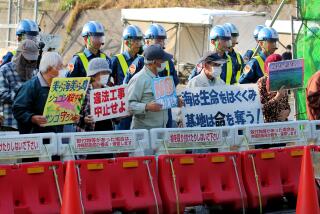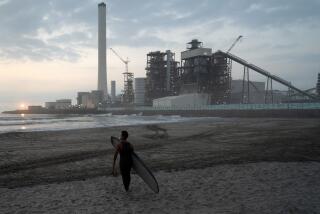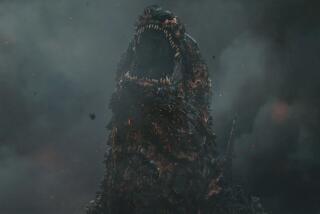1988 Sub Tragedy Offers Insight Into Japan’s Crisis Protocol
TOKYO — The sinking of the Japanese training vessel Ehime Maru by the U.S. nuclear submarine Greeneville has highlighted differences in how the two nations manage similar crises.
A look back at another accident involving a military submarine and a fishing vessel--this one in Tokyo Bay nearly 13 years ago--provides insight into Japanese expectations and how the Asian nation might have handled this year’s accident off Hawaii had both parties been Japanese.
On July 23, 1988, a group of 48 people chartered the 154-ton Daiichi Fujimaru for a day of fishing. It was summer vacation, the sun was shining, and there were very few clouds. Spirits soared as the group headed out about 2:15 in the afternoon for a cruise to Niijima Island.
One father told his son that this was their lucky day and that he expected to catch a big one. Several mothers bade their sons and husbands goodbye, never imagining that it would be the last time they would see them alive.
Just an hour out of port, as the 92-foot Daiichi Fujimaru reached the mouth of Tokyo Bay, many of those on board sighted the 2,200-ton Japanese submarine Nadashio on the surface, returning to nearby Yokosuka naval base after a day of sea exercises.
According to the investigation that ensued, as the submarine got closer, it swerved to avoid a sailboat and crashed headlong into the Daiichi Fujimaru. Within two minutes, the fishing boat sank beneath the waves, claiming 30 lives. None of the Nadashio’s 75 crew members was hurt.
As with the ongoing Ehime Maru case, the sinking of the Daiichi Fujimaru was a huge media story in Japan. Major news organizations assigned as many as 100 reporters each to cover every twist and turn, flew helicopters overhead, chartered boats, printed special editions and broadcast hourly updates.
“There were many false reports,” recalls Masanori Koyama, the attorney who defended the submarine captain. “One Mainichi newspaper reporter entered the hospital in pajamas pretending he was a patient.”
Because everyone involved was Japanese and understood the cultural importance of apologies, submarine Capt. Keisuke Yamashita, wearing street clothes, quickly traveled to the homes of victims’ families and tearfully expressed his heartfelt regret, well before any official blame or responsibility was handed down.
In Japan, an apology does not necessarily signal guilt or legal responsibility but instead acknowledges the pain suffered by the other party--in contrast to the U.S., where those involved in an accident are often reluctant to apologize because it might suggest admission of liability.
In the aftermath of the 1988 accident, the Japanese government also moved quickly and decisively to raise the Daiichi Fujimaru, recover the bodies, pay for the funerals and compensate the victims’ families, all of it without any prodding from the public or the media. Raising a fishing vessel is easier in relatively shallow water than in the 1,800-foot depths off Hawaii, but in retrospect most people give the government high marks for its response.
“On the whole, they dealt with the crisis beautifully,” says Hiroyuki Isaka, a public relations official with a firm that many of the victims worked for. “I had no complaints.”
The government paid $16.7 million to the 30 families--a small amount, perhaps, in America’s litigious society, but generous at the time by Japanese standards. And the payments were handed out within a few months of the accident, well before responsibility was established.
“The [Self-Defense Forces] paid all compensation with sincerity,” recalls Shunichi Tagawa, the attorney who represented the captain of the fishing vessel in later negotiations over blame and compensation. “Then again, it used our tax money. And they would have been in real trouble if they hadn’t.”
A few key figures dutifully took responsibility. But in classic Japanese fashion, those higher up in the hierarchy sacrificed at the altar of public opinion saw their careers resuscitated a few years later.
Tsutomu Kawara resigned as head of Japan’s Defense Agency a month after the accident, but he reappeared in government Cabinets in 1997 and 1999 to handle construction and economic portfolios, by which time his role in the accident was relegated to a footnote.
Both captains were forced to resign but eventually found jobs in the private sector.
Determining who exactly was responsible for Japan’s worst naval accident since World War II took much longer. Japan has no military court system, so over several years the case worked its way through the nation’s cumbersome civilian courts.
In a face-saving early decision, the submarine and fishing boat captains were blamed equally. And each at one point was given a ceremonial jail sentence that was immediately suspended. Only much later, in a 1994 decision, was most of the blame pinned on the submarine captain.
The public in 1988 was generally satisfied with the quick response of Japanese political leaders. This stands in sharp contrast to the intense criticism that Prime Minister Yoshiro Mori has faced this year after his decision to continue playing golf after learning of the Ehime Maru accident.
In the 1988 incident, Prime Minister Noboru Takeshita rushed back from an out-of-town trip. And Keizo Obuchi, secretary-general of the ruling Liberal Democratic Party, canceled a golf game scheduled for the next day.
“The way they reacted was common sense,” says Ryoichi Mikame, a reporter with the daily Mainichi newspaper at the time. “The current government should have done the same last month. Something is really wrong.”
The early anger directed by many Japanese at the U.S. Navy last month echoed the public dismay in 1988, much of which was focused on the Self-Defense Forces. “SDF’s very reason for being was questioned by the nation,” recalls Tadasu Kumagai, a military analyst.
Although the case didn’t involve a foreign military power and left an initial impression that both parties shared blame--in contrast to the Greeneville case--there were several reports that SDF officers stood by and watched people drown. The reports were fanned by a photo taken from a passing boat that showed a woman struggling in the water as crew members appeared to look on idly from the sub’s conning tower.
“SDF had an old military mentality,” attorney Tagawa says. “They had this idea that they were defending the country while we were just playing around on a fishing boat and shouldn’t be in their way. They were arrogant.”
The accidents have one thing in common: the enormous sense of rage and helplessness felt by the victims’ families as they replayed the mental image of a small fishing boat being crushed by a huge military vessel.
Nearly 13 years after the 1988 accident, 67-year-old Hiroko Matsui, the mother of one victim, says her pain has hardly dissipated.
Her son, Shigeki, 29 at the time of the fatal collision, had jumped at the chance to go out on the Daiichi Fujimaru. He loved fishing, had headed a fishing club in college and often brought back his catch for the family to enjoy.
“He left as usual to go fishing. But then he never returned,” Matsui says. “My husband and I and his sister try and survive, but we can never forget.”
The loss of her only son has left her with deep empathy for the families of the Ehime Maru victims. She says she understands that the United States has a different legal system but still believes that the Greeneville’s captain should have apologized much sooner, no matter what system or hierarchy he hails from, to address the feelings of ordinary Japanese people.
She also has harsh words for her prime minister, who would have acted much more forcefully, she believes, if his own family members had been on the Ehime Maru.
Matsui and a few other members of a small memorial society created to honor the Daiichi Fujimaru victims have helped collect hundreds of signatures on a petition to raise the ill-fated Ehime Maru fisheries vessel from the waters off Hawaii and sent $870 to the families.
“I know it’s a pittance, but we wanted to show our feelings,” Matsui says. “Governments and big organizations think individual lives are worthless. It’s just overwhelming that I’ll never see my son again.”
*
Rie Sasaki in The Times’ Tokyo Bureau contributed to this report.
More to Read
Sign up for Essential California
The most important California stories and recommendations in your inbox every morning.
You may occasionally receive promotional content from the Los Angeles Times.










